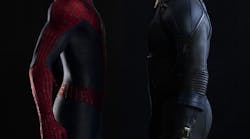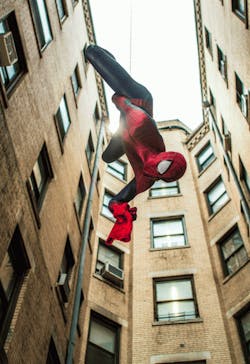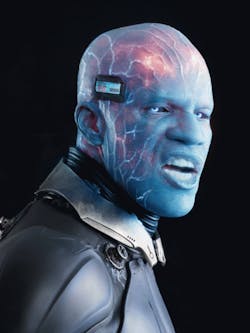Jerome Chen had an arsenal of technologies and “tricks” available as effects supervisor on the new comic-book-driven movie, the Amazing Spiderman 2 from Marvel Comics and Columbia Pictures (opening next month). But he also had to balance the goals of realism and excitement against safety, cost, and time.
In some cases, simple, low-tech solutions did the job. In explosions, for example, bystanders are hurled back, flying through the air as the blast rips by them. In reality, they are being yanked up and back by wires attached to harnesses they wear, a longtime Hollywood trick. The wires are either difficult to see or “erased” in film editing, and are pulled back through pulleys by a few beefy members of the stunt team. Electrically powered drums reel in the wire when more speed and precision are needed.
But the explosions sending bystanders hurtling through the air have come a long way from the days of flash powder and shaky cameras. In this movie, Electro, Spiderman's nemesis, unleashes some high-power plasma bolts on a car or two, leaving them charred hulks of twisted metal. But don’t worry; no cars were harmed in filming those sequences, according to Chen.
Instead, film technicians first used Spheron, a special camera, to capture a 360° high dynamic range image (HDRI) of the scene and all its variations in lighting, color, and shadows — a 2-min process. According to Chen, Spheron was originally developed to capture forensic evidence at crime scenes, but is now widely used by cinematographers for a variety of purposes. In this film, the crews used it to determine the proper color, lighting, and shading to apply to CGI elements.
In the next step, projection mapping takes a photo of an object, say a police car, and projects it onto a computer model that has the same geometry as the car. The director and his computer crew then inflict damage on the model using software that simulates metal denting, twisting, and breaking apart, flames, and smoke. They also add virtual flying debris and car parts, as well as booming stereo sound effects. Next, the carefully edited footage of the model and simulated carnage gets inserted into the scene, using Spheron data to ensure it is lit and shaded correctly to blend into actual footage taken on the location.
Safety takes precedence in film making; no film is worth dying for. So directors and effect supervisors sometimes change their minds when confronted with potentially dangerous stunts, even after planning and agreeing on them. In one scene, for example, Electro is strapped and clamped to a table that gets raised and lowered into a transparent tank of water while scientists examine him. (The character doesn’t have to breathe.)
At first, the plan was to raise and lower the table and actor using a functional robotic arm with some additional hardware added to disguise the fact it was a standard offering from a major robotic firm. The robot would let the director film the scene repeatedly and be confident the arm would always turn in the same flawless performance. An engineer associated with the film assured the director and effects supervisor that the robot had redundant backups and the actor would never be in danger.
But submerging an actor clamped to a table in a tank of water didn’t sit right with the film team. Would the arm react properly in case of a power outage or overload? To be safe, they emptied the tank of water but still used the arm to raise and lower the table, which never did malfunction. Water was added in postproduction as a CGI element.
As in many films, costume designers and make-up personnel had a large hand in the look of Electro. He is burnt and transformed in a truly bizarre industrial accident, so the film crew started by rounding off the actor’s features with latex devices glued to his face, then added a bluish, translucent mask, gloves, and suit.
“We wanted to make it look like electrical energy was pulsating inside him, so we wanted small lightning-bolt patterns visible beneath his skin,” says Chen. “One method was to embed hundreds of fiber-optic traces or thin wires in a silicone suit, then program them to pulse in compelling patterns. But that wasn’t practical in that the suit would be difficult to make, and the thin wires would likely break all the time.”
Instead, they developed a suit and mask, but added the lightning and pulsating effects in CGI.
Another challenge with Electro was filming his destructive lightning bolts. “After researching electric bolts, lightning, and discharges from generators, we knew we wanted a more-unique look,” says Chen. “So we examined images of deep-space nebulae and quickly decided to go with that energy-plasma effect. We even considered building a large Tesla coil to get the right look. In the end, we animated the bolts, making them look three dimensional with swirling shades of orange, purple, and blue.”
To give Electro’s CGI bolts more realism, film technicians used low-tech ingenuity: several 10-kW lights that would discharge or flash in sync with the bolts. The strobes of light would simulate flashes the bolts threw on surrounding buildings and scenery.
Another marriage of high and low-tech took place in bringing Rhino to life. He’s another adversary for Spiderman and wears an armored suit equipped with grenade launchers and machine guns. The 10-ft-tall suit and its movements take place totally in CGI, so no actor suits up in a Rhino costume. But the face of the actor playing Rhino is visible. This was done with film wizardry (more projection mapping) that took film of the actor’s face and positioned it on the suit’s headpiece. To get the right perspective between the actor’s face and surroundings he walks through, the film crew built a large four-wheeled platform for him to stand on that put his head about 10 ft high. Four large men pushed the cart through scenes as cameras captured the facial expressions on the actor/Rhino. But to match the motion of his face with the Rhino’s lumbering stride, the cart had four uneven wheels that made the actor’s head go back and forth. In postproduction, the cart and men were removed, the suit added in, and the actor’s face integrated into the scene.
As Chen says, “We used everything from simple pulleys to robotic arms to reinforce the illusion of Spiderman’s world, not just computerized graphics.”



